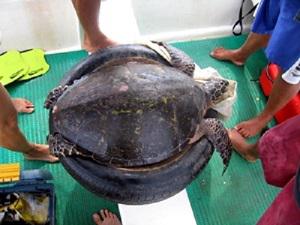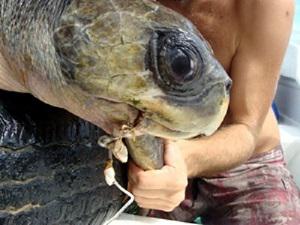Javier Carrión Cortez
This project has two aims:
(i) To study sea turtle’s home range and habitat intensity use and
(ii) To identify the habitat size that need to be managed to protect two sea turtle aggregations at their foraging grounds.

Our first captured hawksbill at Punta Coyote.
Efforts to protect marine endangered species are usually hampered by the lack of spatial dimensions of the areas that need to be protected to assure the survival of the individuals and the quality of the habitat. In the case of long-moving species, such as sea turtles, this information is important as it provides an opportunity to protect critical habitats under the Marine Protected Areas (MPA) scheme. The black (Chelonia mydas) and hawksbill (Eretmochelys imbricata) turtles are species that aggregate to feed in neritic coastal areas. Between these areas, Magdalena Bay (Baja California Peninsula, Mexico) and Punta Coyote (North Pacific coast of Costa Rica) have been identified as important foraging grounds for black and hawksbill turtles in the Eastern Pacific, an oceanic basin where these two species have been almost depleted.

Threats for sea turtles near Punta Coyote. A olive ridley (Lepidochelys olivacea) with a long line hook.
Therefore, the objectives of the present study are:
(i) to estimate the home range size of hawksbill and black turtles at two foraging grounds in the Eastern Pacific;
(ii) to describe and quantify the diet components consumed by the turtles in order to identify feeding preferences;
(iii) to determine the abundance of the food resources to understand how this variable influence the turtle’s habitat intensity use.
We will tag turtles with acoustic transmitters to study the home range. Tagged turtles will be tracked from a boat and GPS points will be recorded at each turtle sighting. Home range size will be estimated with the Minimum Convex Polygon (MCP) and Fixed Kernel Density Estimator (FKD) using the software Arc View 3.2 + Animal Movement Analyses Extension.
To study the diet we will collect esofagic samples following the technique proposed by Forbes and Limpus (1993). The most important food items will be monitored to determine the abundance and distribution of turtle’s food resources in the study sites. Finally, we will determine if does exists a relationship between the habitat intensity use and the abundance and distribution of the food resources in the environment.
Conservation implications:
At the end of the study, we pretend to contribute manager’s effort to identify priority areas for conservation to protect these turtle’s aggregations from local threats, such as shrimp trawling, gill-netting, long lining and poaching. In the case of Punta Coyote this information will support current attempts to extend a Wildlife Refuge located just south of the study site. By the other hand, current efforts to declare certain localities of Magdalena Bay a sea turtle Sanctuary will be complemented with our results.